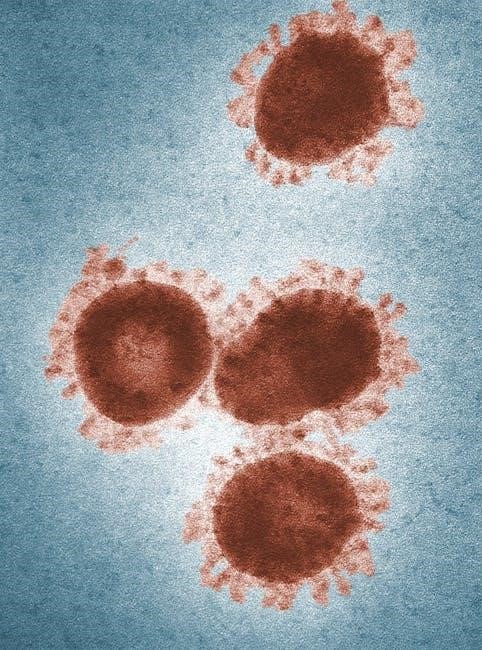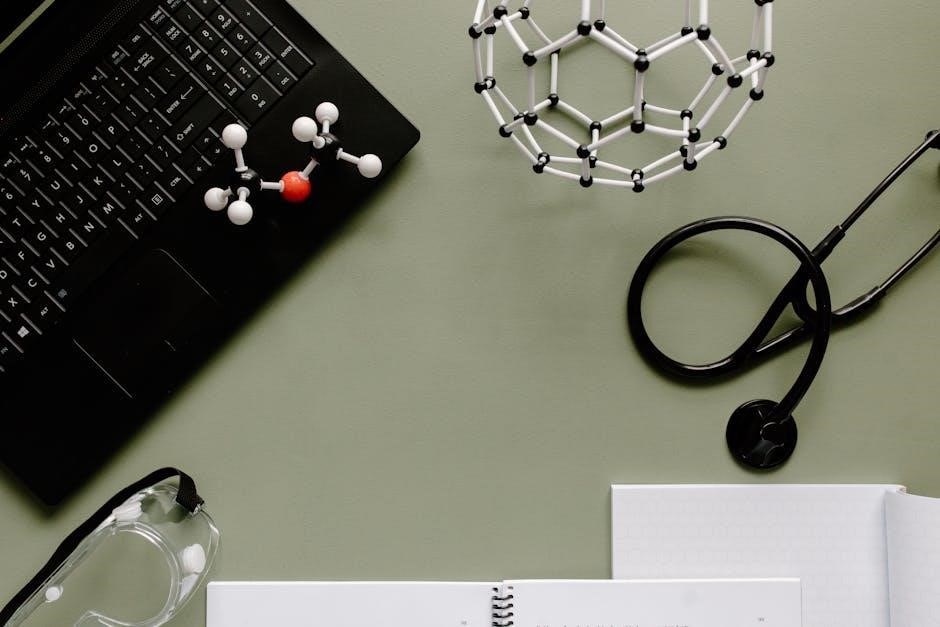Welcome to the Biology Final Exam Study Guide! This comprehensive resource covers major topics, effective study strategies, and practical tips to help you prepare confidently for your exam.
1.1. Understanding the Exam Format
The biology final exam format typically includes multiple-choice questions, short-answer responses, and essay sections. Timing and question distribution vary, so familiarize yourself with the structure beforehand. Practice under timed conditions to improve pacing. Review past papers to identify common question patterns and focus on high-weightage topics. Understanding the format helps allocate study time effectively and reduces exam-day anxiety. Use this knowledge to tailor your preparation and approach each section confidently.
1.2. Key Topics Covered
The biology final exam covers essential topics such as cell structure, genetics, evolution, and ecosystems. Key areas include photosynthesis, cellular respiration, and the immune system. Students should focus on understanding processes like DNA replication, Mendelian inheritance, and natural selection. Additionally, topics like energy flow, nutrient cycles, and human impacts on ecosystems are critical. Familiarize yourself with lab techniques and experimental designs, as these are often included. Prioritize studying mechanisms and applications, as they are frequently tested. This section ensures you’re well-prepared for the exam’s core content.
1.3. Effective Study Strategies
Active learning techniques, such as summarizing notes and self-quizzing, enhance retention. Use flashcards to memorize key terms and concepts. Regularly review past exams to identify common question patterns and focus on weak areas. Prioritize topics based on exam weightage and create a study schedule. Stay organized by grouping related topics and using visual aids like diagrams. Combining these strategies ensures comprehensive preparation and boosts confidence for the biology final exam.

Cell Structure and Function
Explore the cell membrane and transport mechanisms, organelles like mitochondria and ribosomes, and processes such as cell division and the cell cycle, essential for life and growth.
2.1. Cell Membrane and Transport
The cell membrane is a dynamic, semi-permeable structure composed of a phospholipid bilayer embedded with proteins. It regulates the movement of materials through passive transport (e.g., diffusion, osmosis) and active transport, which requires energy. Key concepts include the fluid mosaic model, membrane permeability, and transport mechanisms like ion channels and carrier proteins. Understanding how substances enter and exit cells is crucial for cellular function and homeostasis. This section will detail the structure and function of the cell membrane and its role in maintaining cellular integrity.
- Passive transport: Diffusion, osmosis, facilitated diffusion.
- Active transport: Energy-dependent processes like sodium-potassium pumps.
- Endocytosis and exocytosis: Vesicle-mediated transport.
2.2. Organelles and Their Roles
Organelles are specialized structures within cells, each performing unique functions essential for cellular operation. The nucleus stores genetic material, while mitochondria generate energy through ATP production. The endoplasmic reticulum synthesizes proteins, and the Golgi apparatus modifies them for transport. Ribosomes produce proteins, lysosomes degrade cellular waste, and the cytoskeleton provides structural support. Understanding the roles of these organelles is vital for grasping cellular processes and their interconnected functions in maintaining life.
- Nucleus: Genetic material storage and transcription regulation.
- Mitochondria: Energy production via cellular respiration.
- Endoplasmic reticulum: Protein synthesis and transport.
- Golgi apparatus: Protein modification and secretion.
- Ribosomes: Protein synthesis from amino acids.
- Lysosomes: Cellular digestion and recycling.
- Cytoskeleton: Structural support and transport.
2.3. Cell Division and the Cell Cycle
Cell division is essential for growth, repair, and reproduction. The cell cycle consists of four phases: G1 (growth), S (DNA synthesis), G2 (preparation), and M (mitosis and cytokinesis). Mitosis ensures genetic material is evenly distributed, while cytokinesis divides the cytoplasm. Proper regulation prevents uncontrolled cell growth, maintaining tissue health. Understanding the checkpoints and regulatory mechanisms is crucial for grasping cellular reproduction and its role in development and disease.
- G1: Cell growth and preparation for DNA replication.
- S: DNA synthesis and replication.
- G2: Final preparation for mitosis.
- M: Mitosis and cytokinesis.

Genetics and DNA
Genetics and DNA are fundamental to understanding heredity and variation. This section explores DNA structure, genetic inheritance, and modern techniques, providing insights into how genes shape life and evolution.
3.1. DNA Structure and Replication
DNA’s double-helix structure consists of sugar-phosphate backbones and nitrogenous base pairs (A-T, C-G). Replication is semi-conservative, involving helicase, DNA polymerase, and ligase. Enzymes unwind DNA, replicate strands, and seal gaps, ensuring genetic fidelity. This process is crucial for cell division and inheritance, maintaining species continuity through accurate duplication of genetic material.
3.2. Mendelian Genetics and Inheritance
Mendelian genetics explores how traits are inherited through the transmission of alleles. Key principles include the Law of Segregation and the Law of Independent Assortment, which explain how alleles separate and combine during gamete formation. Dominant and recessive traits determine phenotypic ratios in offspring, observable in Punnett squares. This foundational understanding of heredity applies to both simple and complex traits, forming the basis of modern genetic studies and predictions of inheritance patterns in populations.
3.3. Modern Genetic Techniques
Modern genetic techniques have revolutionized the field of biology, enabling precise manipulation and analysis of genetic material. Key methods include CRISPR-Cas9 for gene editing, PCR for amplifying DNA, and DNA sequencing for identifying genetic sequences. These tools allow scientists to study gene function, modify organisms, and diagnose genetic disorders. Additionally, genetic engineering enables the transfer of genes between species, with applications in agriculture, medicine, and biotechnology. Understanding these techniques is crucial for advancing genetic research and solving real-world problems.

Evolution and Natural Selection
Evolution and natural selection are fundamental concepts in biology, explaining how species adapt and diversify over time. Key topics include mechanisms of evolution, evidence supporting these processes, and the role of genetic variation and environmental pressures in driving change. Understanding speciation, adaptation, and phylogeny is essential for grasping how life on Earth has diversified.
4.1. Mechanisms of Evolution
The mechanisms of evolution include natural selection, genetic drift, mutation, and gene flow. Natural selection drives adaptation by favoring traits that enhance survival and reproduction. Genetic drift introduces random changes in allele frequencies, while mutations provide new genetic variation. Gene flow transfers genes between populations, maintaining genetic diversity. These processes collectively shape the evolution of species, ensuring they adapt to environmental challenges and ecological niches, and are critical for understanding biodiversity and the dynamics of life on Earth over time.
4.2. Evidence for Evolution
The evidence for evolution is diverse and well-documented. Fossil records reveal transitional forms, showing gradual changes in species over time. Comparative anatomy and embryology highlight homologous structures, indicating common ancestry. Molecular biology provides genetic evidence, such as shared DNA sequences and proteins across species. Biogeography explains species distribution patterns consistent with evolutionary history. Additionally, observable evolutionary changes, like antibiotic resistance in bacteria, demonstrate evolution in action. These lines of evidence collectively confirm the theory of evolution as a fundamental biological process;
4.3. Speciation and Phylogeny
Speciation is the process through which new species emerge, often due to reproductive isolation. Allopatric speciation occurs when geographic barriers separate populations, while sympatric speciation happens without physical separation. Phylogeny studies the evolutionary relationships among organisms, constructed using shared traits and genetic data. Phylogenetic trees illustrate these relationships, with branches representing divergence points. Biogeography and molecular clocks further support these analyses. Understanding speciation and phylogeny provides insights into biodiversity and the interconnectedness of life, essential for evolutionary biology studies.

Photosynthesis and Cellular Respiration
Mastering photosynthesis and cellular respiration is crucial for understanding energy conversion in living organisms. These processes highlight how plants produce energy and cells release it, emphasizing their interdependence and ecological significance. Use diagrams and practice questions to grasp these topics effectively, focusing on light-dependent reactions, Calvin cycle, glycolysis, Krebs cycle, and electron transport chains. Understanding these processes at the molecular level is key to excelling in your biology exam.
5.1. Photosynthesis Process
Photosynthesis occurs in chloroplasts and involves converting light energy into chemical energy. The process includes two main stages: the light-dependent reactions and the Calvin cycle. In the light-dependent reactions, light is absorbed by pigments like chlorophyll, exciting electrons that generate ATP and NADPH. The Calvin cycle uses these molecules to fix carbon dioxide into glucose. Oxygen is released as a byproduct. Understanding the roles of chlorophyll, stomata, and enzyme activity is crucial. Practice diagrams and equations to grasp the flow of energy and molecules in this vital process for life on Earth.
5.2. Cellular Respiration Stages
Cellular respiration involves three main stages: glycolysis, the Krebs cycle, and the electron transport chain. Glycolysis breaks down glucose into pyruvate, producing 2 ATP and NADH. The Krebs cycle converts pyruvate into acetyl-CoA, generating more ATP and NADH while releasing carbon dioxide. The electron transport chain uses oxygen to produce a large amount of ATP through oxidative phosphorylation. Oxygen acts as the final electron acceptor, enabling ATP synthesis. Understanding the roles of key molecules like ATP, NADH, and oxygen is essential. Practice diagrams to trace the flow of energy and molecules through each stage.
5.3. Comparison of Both Processes
Photosynthesis and cellular respiration are complementary processes. Photosynthesis converts light energy into chemical energy, producing glucose and oxygen, while cellular respiration breaks down glucose to release energy, producing carbon dioxide and water. Both processes involve ATP production and electron transport chains but occur in opposite directions. Photosynthesis requires chlorophyll and light, whereas cellular respiration relies on oxygen. Understanding their interdependence and energy flow is critical for grasping how life sustains itself. Use diagrams to compare inputs, outputs, and energy transformations in both processes for better retention.

Ecology and Ecosystems
Ecology explores interactions between organisms and their environment, focusing on energy flow, nutrient cycles, and community dynamics. Understanding ecosystems helps predict environmental impacts and conservation strategies.
6.1. Ecosystem Components
Ecosystems consist of biotic and abiotic components. Biotic factors include producers (plants, algae), consumers (herbivores, carnivores), and decomposers (fungi, bacteria). Abiotic factors are non-living elements like light, temperature, water, and nutrients. Understanding these interactions is crucial for analyzing energy flow and nutrient cycling within ecosystems. Each component plays a vital role in maintaining balance and supporting life. Studying these elements helps in grasping ecological principles and predicting environmental changes. This section covers the fundamental parts of ecosystems and their interconnected roles.
6.2. Energy Flow and Nutrient Cycles
Energy flows through ecosystems in a unidirectional manner, beginning with producers who capture sunlight through photosynthesis. This energy is transferred to consumers at each trophic level, with only about 10% passing to the next level. Nutrient cycles, such as carbon, nitrogen, and phosphorus cycles, ensure the reuse of essential elements. Decomposers play a key role in breaking down organic matter, releasing nutrients back into the environment. Understanding these processes is vital for grasping how ecosystems function and sustain life. This section explores the dynamics of energy flow and nutrient recycling in ecosystems.
6.3. Human Impact on Ecosystems
Human activities significantly alter ecosystems, often leading to habitat destruction, pollution, and climate change. Deforestation disrupts biodiversity, while industrial emissions contribute to global warming. Pollution from plastics, chemicals, and fertilizers harms aquatic life and soil health. Overexploitation of resources, such as overfishing and logging, depletes populations and ecosystems. Conservation efforts, like reforestation and renewable energy, can mitigate these impacts. Understanding human effects on ecosystems is crucial for developing sustainable practices and preserving natural balance for future generations.

The Immune System
The immune system is a complex defense mechanism protecting the body from pathogens and diseases. It involves both innate and adaptive immunity, ensuring health and preventing infections effectively.
7.1. Components of the Immune System
The immune system comprises various components, including physical barriers like the skin and mucous membranes, and internal defenses such as lymph nodes, spleen, and lymphocytes (B cells and T cells). These elements work together to prevent infections and diseases by recognizing and neutralizing pathogens. The immune system also involves specialized cells like macrophages and dendritic cells, which play a crucial role in identifying foreign substances and initiating immune responses. Understanding these components is essential for grasping how the immune system functions effectively to protect the body.
7.2. Immune Responses
Immune responses are the body’s defense mechanisms against pathogens and foreign substances. They involve two main systems: the innate immune system, which provides immediate, non-specific defense through physical barriers, phagocytic cells, and inflammatory responses, and the adaptive immune system, which offers specific, long-lasting protection through lymphocytes (B cells and T cells). Adaptive immunity involves antibody production by B cells and direct cellular attacks by T cells, while memory cells ensure faster responses to future infections. Understanding these processes is crucial for comprehending immune system functionality and its role in maintaining health.
7.3. Immunological Disorders
Immunological disorders occur when the immune system malfunctions, leading to diseases. These include autoimmune diseases, where the immune system attacks the body’s own cells, such as rheumatoid arthritis and lupus. Immunodeficiency disorders, like HIV/AIDS, result from a weakened immune response. Allergies and hypersensitivities are overactive immune reactions to harmless substances. Understanding these conditions, their causes, and their effects on the body is essential for studying the immune system’s role in health and disease, making them a key topic in biology exams.

Study Tips and Tricks
Master biology with active learning techniques, flashcards, and mnemonics. Prioritize time management and stay organized to ensure comprehensive preparation for your final exam, helping you ace it confidently.
8.1. Active Learning Techniques
Active learning techniques, such as note-taking, summarizing concepts, and creating diagrams, enhance engagement with biology material; Use mnemonics to memorize processes and structures. Apply search strategies like specific keywords and Boolean operators to find academic resources efficiently, ensuring access to relevant study materials. These methods foster deeper understanding and retention, enabling confident exam preparation.
8.2. Using Flashcards and Mnemonics
Flashcards are an excellent tool for memorizing biology terms and concepts. Write key terms on one side and definitions or explanations on the other. Mnemonics, such as acronyms or rhymes, help retain complex information, like cellular processes or DNA structures. Use digital apps or physical cards for convenience. Regular review reinforces memory and enhances active learning, ensuring you grasp essential biology topics effectively for your exam.
8.3. Time Management Strategies
Effective time management is crucial for successful exam preparation. Create a detailed study schedule to allocate specific blocks of time for each biology topic. Prioritize challenging subjects and break study sessions into manageable intervals, such as 45 minutes of focused learning followed by short breaks. Avoid procrastination by setting realistic daily goals and sticking to them. Regularly review and adjust your schedule to ensure it aligns with your progress. Consistency and efficiency are key to mastering biology concepts without overwhelming yourself.

Practicing with Past Exams
Familiarize yourself with past exams to understand the format, identify trends, and refine your test-taking skills. This practice helps you anticipate questions and improve your performance effectively.
9.1. Locating Reliable Practice Exams
To find reliable practice exams, start by checking your institution’s resources or official course websites. Use specific search terms like “biology final exam practice” or “past papers” to narrow results. Utilize academic databases or platforms like Google Scholar for credible materials. Additionally, websites such as MindTools or educational forums often provide exam samples. Always verify the source’s credibility to ensure the exams align with your curriculum. This targeted approach ensures you access relevant and high-quality practice materials to aid your exam preparation effectively.
9.2. Analyzing Common Exam Questions
Analyzing common exam questions helps identify key topics and recurring themes. Review past papers to spot frequently tested concepts, such as photosynthesis or genetics. Look for question patterns, like case studies or data interpretation. Pay attention to command words like “explain” or “compare” to understand expected responses. This analysis enables focused studying, ensuring you’re well-prepared for likely questions. Use this insight to prioritize your revision and practice answering similar queries to build confidence and improve exam performance effectively.
9.3. Learning from Mistakes
Mistakes are valuable learning opportunities. Review incorrect answers to understand where you went wrong. Identify weak areas and focus on improving them. Create a study plan targeting these topics. Test yourself again on similar questions to reinforce learning. Seek feedback from instructors or peers to refine your understanding. Remember, mistakes are part of the learning process, and addressing them enhances your knowledge and exam performance. Use these insights to refine your study strategies and approach challenges with confidence.

Final Review and Preparation
Organize your study materials, review key concepts, and ensure mental readiness. A structured approach to final preparation enhances confidence and performance on exam day.
10.1. Creating a Study Schedule
Developing a detailed study schedule is crucial for effective exam preparation. Allocate specific time slots to each biology topic, ensuring balanced coverage of all sections. Start with foundational concepts and gradually move to complex areas. Incorporate regular breaks to maintain focus and prevent burnout. Prioritize weak areas and review notes systematically. Adjust the schedule as needed based on progress. Consistency is key to retaining information and building confidence for the final exam.
10.2. Staying Motivated and Focused
Maintaining motivation and focus is essential for successful exam preparation. Set clear, achievable goals and celebrate progress to stay encouraged. Use active learning techniques like summarizing notes or teaching concepts to others. Minimize distractions by creating a quiet study environment. Incorporate regular physical activity and mindfulness exercises to refresh your mind. Surround yourself with supportive peers who share your commitment to success. Remind yourself of the importance of the exam and visualize achieving your desired results to stay driven and focused throughout your study journey.
10.3. Rest and Nutrition Before the Exam
Adequate rest and proper nutrition are vital for optimal brain function. Ensure 7-9 hours of sleep before the exam to enhance memory retention and focus. Eat nutrient-rich meals, including fruits, vegetables, and whole grains, to fuel your mind. Stay hydrated with water and avoid sugary or processed foods that can cause energy crashes. Incorporate light exercise to reduce stress and improve circulation. Avoid heavy meals close to bedtime and maintain a consistent routine to ensure peak performance on exam day.
